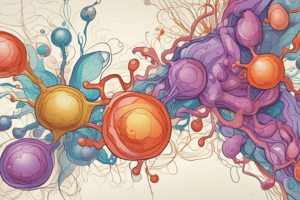Podcast
Questions and Answers
What is the primary component of fat deposits and food?
What is the primary component of fat deposits and food?
- Phospholipids
- Triacylglycerols (correct)
- Sphingolipids
- Glycosphingolipids
What is the function of inositol phospholipids in the cell membrane?
What is the function of inositol phospholipids in the cell membrane?
- They help in cell adhesion and cell recognition
- They are components of lung surfactant
- They are involved in the metabolism of glycolipids
- They act as precursors of hormone second messengers (correct)
What is di-palmitoyl lecithin a major component of?
What is di-palmitoyl lecithin a major component of?
- Adipose tissue
- Cell membranes
- Lung surfactant (correct)
- Glycocalyx
What is the primary location of glycosphingolipids in the cell?
What is the primary location of glycosphingolipids in the cell?
What is the function of platelet activating factor?
What is the function of platelet activating factor?
What is the result of a genetic defect in the pathway for glycolipid degradation in the lysosomes?
What is the result of a genetic defect in the pathway for glycolipid degradation in the lysosomes?
What is the first step in the catabolism of triacylglycerols?
What is the first step in the catabolism of triacylglycerols?
Where does much of the hydrolysis of triacylglycerols occur?
Where does much of the hydrolysis of triacylglycerols occur?
What is the concentration of platelet-activating factor (PAF) required to aggregate platelets?
What is the concentration of platelet-activating factor (PAF) required to aggregate platelets?
What is the effect of platelet-activating factor (PAF) on blood pressure?
What is the effect of platelet-activating factor (PAF) on blood pressure?
Which enzyme is responsible for the formation of lysolecithin from lecithin?
Which enzyme is responsible for the formation of lysolecithin from lecithin?
What is the product of phospholipase A2 catalyzed hydrolysis of glycerophospholipids?
What is the product of phospholipase A2 catalyzed hydrolysis of glycerophospholipids?
Which phospholipase is involved in mammalian signal transduction?
Which phospholipase is involved in mammalian signal transduction?
What is the function of acyl-CoA in the re-synthesis of phospholipids?
What is the function of acyl-CoA in the re-synthesis of phospholipids?
What is the role of lysophospholipase in phospholipid degradation?
What is the role of lysophospholipase in phospholipid degradation?
What is the product of phospholipase C catalyzed hydrolysis of glycerophospholipids?
What is the product of phospholipase C catalyzed hydrolysis of glycerophospholipids?
What is the primary source of energy for tissues that uptake free fatty acids?
What is the primary source of energy for tissues that uptake free fatty acids?
In which tissue is glycerol kinase enzyme not found in significant amounts?
In which tissue is glycerol kinase enzyme not found in significant amounts?
What is the role of glycerol-3-phosphate dehydrogenase in muscle or adipose tissue?
What is the role of glycerol-3-phosphate dehydrogenase in muscle or adipose tissue?
What is the precursor to triacylglycerols, phosphoglycerols, and cardiolipin?
What is the precursor to triacylglycerols, phosphoglycerols, and cardiolipin?
What type of link is present in plasmalogens and platelet-activating factor (PAF)?
What type of link is present in plasmalogens and platelet-activating factor (PAF)?
What is the significance of glycerol-3-phosphate and dihydroxyacetone phosphate in metabolism?
What is the significance of glycerol-3-phosphate and dihydroxyacetone phosphate in metabolism?
What is the role of ATP in the biosynthesis of triacylglycerols and phosphoglycerols?
What is the role of ATP in the biosynthesis of triacylglycerols and phosphoglycerols?
What is the enzyme that catalyzes the activation of glycerol to sn-glycerol 3-phosphate?
What is the enzyme that catalyzes the activation of glycerol to sn-glycerol 3-phosphate?
Why can't glycerol be utilized for the provision of glycerol 3-phosphate in adipose tissue?
Why can't glycerol be utilized for the provision of glycerol 3-phosphate in adipose tissue?
What is the function of hormone-sensitive lipase?
What is the function of hormone-sensitive lipase?
What happens to the glycerol released from adipose tissue?
What happens to the glycerol released from adipose tissue?
What is the function of acyl-CoA synthetase?
What is the function of acyl-CoA synthetase?
What is the result of the rate of re-esterification not matching the rate of lipolysis?
What is the result of the rate of re-esterification not matching the rate of lipolysis?
How does increased glucose metabolism affect FFA outflow?
How does increased glucose metabolism affect FFA outflow?
What is the effect of glucose on glycerol release?
What is the effect of glucose on glycerol release?
What is one of the pathways glucose can take in adipose tissue?
What is one of the pathways glucose can take in adipose tissue?
What is the function of LCAT in the formation of HDL?
What is the function of LCAT in the formation of HDL?
What is the role of apo A-I in HDL metabolism?
What is the role of apo A-I in HDL metabolism?
What is the function of HDL in removing excess cholesterol?
What is the function of HDL in removing excess cholesterol?
What is the role of the class B scavenger receptor B1 (SR-B1) in HDL metabolism?
What is the role of the class B scavenger receptor B1 (SR-B1) in HDL metabolism?
What is the result of the conversion of surface phospholipid and free cholesterol into cholesteryl esters and lysolecithin?
What is the result of the conversion of surface phospholipid and free cholesterol into cholesteryl esters and lysolecithin?
What is the significance of HDL in maintaining cholesterol homeostasis?
What is the significance of HDL in maintaining cholesterol homeostasis?
What is the role of apo C and apo E in HDL metabolism?
What is the role of apo C and apo E in HDL metabolism?
What is the result of the interaction between HDL and specific cell surface receptors?
What is the result of the interaction between HDL and specific cell surface receptors?
Flashcards are hidden until you start studying
Study Notes
Metabolism of Acylglycerols and Sphingolipids
- Acylglycerols constitute the majority of lipids in the body, with triacylglycerols being the major lipids in fat deposits and food.
- Phospholipids and sphingolipids have an amphipathic nature, making them suitable as the main lipid component of cell membranes.
- Phospholipids also participate in the metabolism of many other lipids and have specialized functions, such as in lung surfactant and hormone signaling.
Biomedical Importance
- Phospholipids and sphingolipids have biomedical importance in respiratory distress syndrome, hormone signaling, and cell recognition and adhesion.
- Glycolipids, including glycosphingolipids, form part of the glycocalyx and are involved in cell adhesion and recognition, bacterial toxin receptors, and ABO blood group substances.
- Defects in glycolipid degradation lead to glycolipid storage diseases, such as Gaucher's disease and Tay-Sachs disease.
Hydrolysis of Triacylglycerols
- Triacylglycerols must be hydrolyzed by a lipase to their constituent fatty acids and glycerol before further catabolism can proceed.
- Hydrolysis occurs in adipose tissue, releasing free fatty acids into the plasma, which are then taken up by tissues for oxidation or re-esterification.
Biosynthesis of Triacylglycerols and Phosphoglycerols
- Triacylglycerols and phosphoglycerols are formed by acylation of triose phosphates.
- Glycerol-3-phosphate and dihydroxyacetone phosphate are intermediates in glycolysis, making a connection between carbohydrate and lipid metabolism.
- Phosphatidate is the common precursor in the biosynthesis of triacylglycerols, phosphoglycerols, and cardiolipin.
Phospholipases
- Phospholipases allow degradation and remodeling of phosphoglycerols, with different turnover rates for each portion of the molecule.
- Phospholipase A2 catalyzes the hydrolysis of glycerophospholipids to form a free fatty acid and lysophospholipid.
- Phospholipase C is involved in mammalian signal transduction, and phospholipase D is involved in platelet activation.
Cholesterol Metabolism
- HDL (high-density lipoprotein) plays a critical role in removing excess unesterified cholesterol from lipoproteins and tissues.
- Lecithin: cholesterol acyltransferase (LCAT) facilitates the formation of cholesteryl esters and lysolecithin in HDL.
- HDL interacts with specific cell surface receptors to transport cholesterol back to the liver for excretion, maintaining cholesterol homeostasis and protecting against cardiovascular disease.
Studying That Suits You
Use AI to generate personalized quizzes and flashcards to suit your learning preferences.




